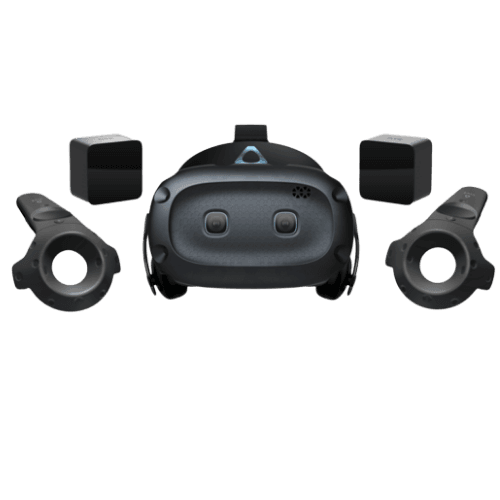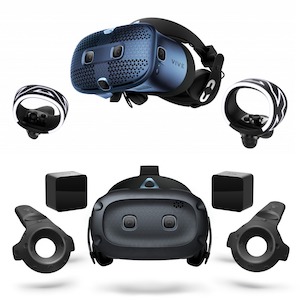HTC Vive Cosmos and Cosmos Elite review: Any good in 2023?
Summary
Quick Verdict: The Cosmos and Cosmos Elite are starting to show their age, but still deliver a solid PCVR experience. They’re relatively comfortable and offer a visual experience that still delivers the goods for most games. You just need to find it at the right price to get your value out of it.
- Offers HTC quality without Base Stations
- Immersive visual experience
- Access to SteamVR and VivePort ecosystems
- Works with Pro series accessories
- Due for a price drop
- Uses dated Base Stations and controllers
- Design not as comfortable as the Pro 2
- Horrid battery life in controllers
Originally released in October of 2019, the HTC Vive Cosmos, and its partner in crime the Cosmos Elite, brought something new to the VR headset table. An adaptable headset, that could use inside-out built-in tracking, like an Oculus Quest 2, or via an upgradeable faceplate that utilises external tracking, such as with Valve Index.
For gamers without the space or means to mount base stations, it gave them an opportunity to enjoy high-end HTC VR quality, with the option to adapt to external tracking in the future.
Since ist release we've seen the emergence of the HTC Vive Pro 2. That new PCVR headset certainly steps things up significantly in regard to resolution, field-of-view and headset design. Yet its steep asking price means there's still a market for the Cosmos and the Cosmos Elite.
So, are these headsets still worth considering in 2023?
HTC Vive Cosmos vs Cosmos Elite
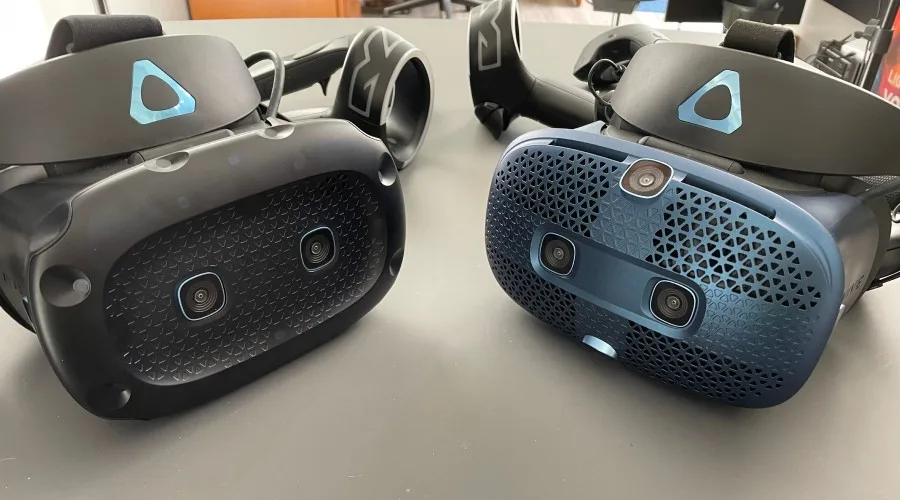
Image: Chris Stead/Finder
The confusing aspect of the nomenclature in the Cosmos range is the use of the word Elite. "Elite" suggests better, but in truth it's just different. Indeed, both headsets feature the same design and specifications, and they play the same games through VivePort and SteamVR.
Where they differ is in tracking.
The blue faceplate on the front of the HTC Vive Cosmos brings 6 cameras into the mix for inside-out tracking. It then provides a bespoke controller with a lit halo design to then allow your movements to be tracked by said cameras.
The Cosmos Elite uses the same Base Station tracking system as the HTC Vive Pro series and reverts to the same "wand" controller. It's worth noting that the Cosmos Elite kit only ships with the original Base Station 1.0 lighthouse system, and the original Wand controller, not the 2018 updated model.
Note: You may come across a Vive Cosmos Play and a Vive Cosmos XR on your travels. The former was a cheaper variant with just 4 (as opposed to 6) inside-out tracking cameras, while the former was a faceplate variant bringing AR and VR together in the one mask. But both appear to be discontinued and are not available through the official Vive store.
Features and specifications
As mentioned, both versions of the HTC Vive Cosmos PCVR headset have the same specifications. You're looking at two 1440 x 1700 pixels LCD lenses. You've got a 90Hz refresh rate and a maximum 110-degree field of view. These core specs were pretty good circa 2019, holding its own against the Oculus Rift and Valve Index.
However, it's since been passed by some margin by the HTC Vive Pro 2, the HP Reverb G2 and is even given a run by the Oculus Quest 2. But as I will go into when we talk performance, specs aren't the be-all-and-end-all of VR headsets currently.
Elsewhere you will find stereo headphones, an integrated mic, an adjustable 61-73mm interpupillary distance (IDP) dial, controllers with 6 degrees of freedom and it weighs in at 702g.
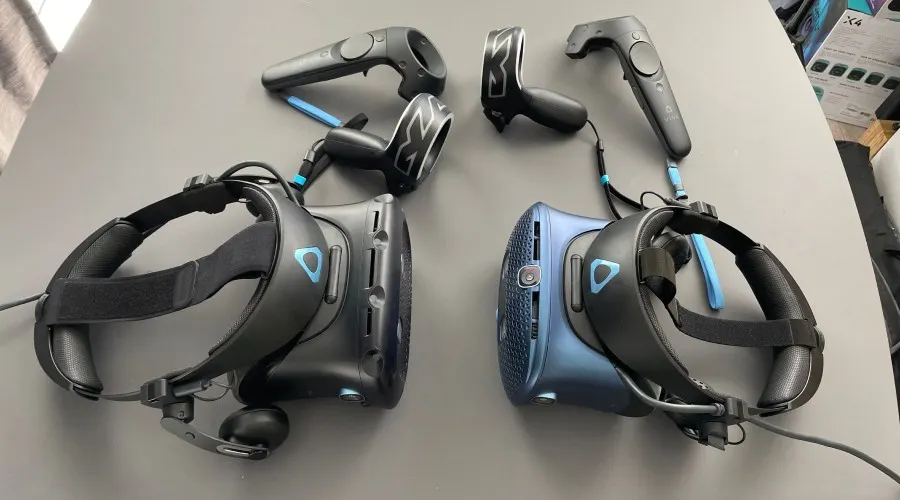
Image: Chris Stead/Finder
Set-up
Regular readers of my VR reviews will know I find the Base Station set up process a pain, and it's the same here with the Cosmos Elite. You need to wall mount the Base Stations or stick them on tripods. You'll need to update them, as well as the headset, the controllers, your PC drivers, and likely Steam as well. Then install VivePort and Vive Console.
Plus, you need power points for both Base Stations, your computer, the headset and to charge the controllers. And, like the Pro 2, the Cosmos range uses power points that take up two spots. Grrr! Adding to the task, the older Base Stations that come in the kit are a bit more particular in how they need to be set up to work.
The Vive Cosmos is a little easier for obvious reasons. You'll still have to get everything set up and working on your PC or laptop. Remembering that you need a Display Port on said laptop or a Display Port to Thunderbolt connector. But you don't have to deal with base stations. This is the big "win" of the Cosmos over the Cosmos Elite. And I must say it was nice just being able to set the floor height, map out a boundary, and get playing without kerfuffle.
The SteamVR and VivePort front ends are both perfectly suitable storefronts and hubs. Switching between and buying games is simple. And because all the software and interface are off-device, you're not losing out by getting an older VR headset.
Design
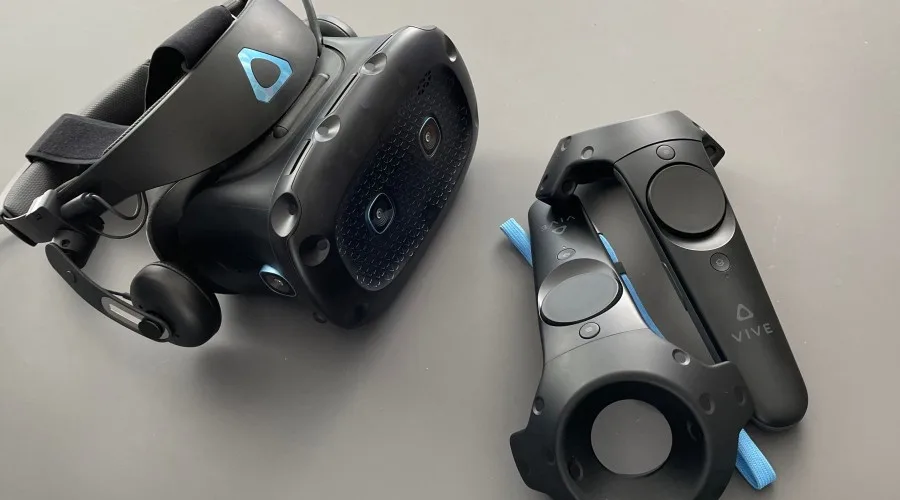
Image: Chris Stead/Finder
Neither the Vive Cosmos nor the Cosmos Elite are the best-looking VR headsets going around. The Vive Cosmos has its bright blue faceplate, and the Cosmos Elite looks like it has been punched in the head by a bigger faceplate.
The headphone cups also look flimsy and cheap, and they feel that way to use, too. Fiddling with them and trying to manoeuvre them into the right place is like trying to stuff too much cardboard into your bin. It's annoying to get it in there, and then it just pops back out anyway. You can plug in your own earphones, but these connect at the ear cup and you'll need to convert your 3.5mm jack from male to female to make it work.
The headset does do a good job of keeping light out, and I didn't find it too difficult to adjust to my head shape. It is a bit front heavy, so you do feel like you need to tighten the back quite a bit that can put a bit too much pressure on your temples and skull. The flip up mask is a novel approach, but when it's raised the weight distribution is even worse. I found myself using passthrough or just taking off the headset instead.
Perhaps I would have had a different opinion if I was reviewing this headset when it first came out. But I find the design just feels its age and I longed for the comfort and balance of the Vive Pro 2.
Controllers

Image: Chris Stead/Finder
The gold standard for me in 2023 is the Valve Index controllers, themselves now 2 years old. I've seen some complaints here and there, but I find them easy to hold, the buttons well positioned, it has finger-tracking and a good solid 7 to 8 hours of battery life. When you're looking at inside-out tracking, the Meta Quest 2 controllers stand out. Again, I love the way they feel in my hands and the battery life is exceptional.
By comparison, both variants of the Cosmos fall short. The Cosmos Elite is the least offensive. The wand controller has been around for many years now and still does an admirable job. It tracks well, it's easy to wrap your fingers around and the 6-hour battery life is middling. Its main crime is that it hasn't been updated in way too long.
(There's definitely an argument to just buy the headset and then get the Valve Index controllers and Base Stations separately!)
The Vive Cosmos controllers are a different beast, unique to the HTC range because of the inside-out tracking requirements. They fit well enough in your hands, better than the newer Focus 3 variants, and track a lot better now than they did at launch. But the oddly egg-shaped halo with its in-built lighting increases the contact zone and creates a balance issue.
But more of a let-down is the battery life. They take 2 AA batteries each, and you'll be lucky to get 3 hours out of them. That's poor on many levels, not to mention the impact on the environment.
Performance
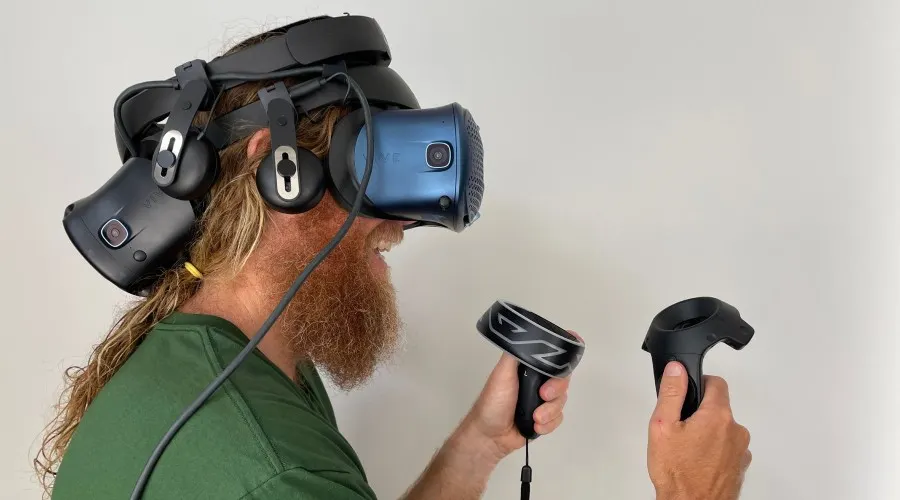
Image: Chris Stead/Finder
While the resolution of the HTC Vive Cosmos and Cosmos Elite may not sound as exciting in 2023 as it did in 2019, the headsets still both deliver a good visual experience. There's no screen door effect to worry about here and games generally look great. Assuming you have a good enough PC or gaming laptop to run VR at a good clip, of course. I did find the panels to produce imagery a little darker than the Pro 2 or Index, but it wasn't overly concerning.
More of an issue is the field of view. The advertised 110 degrees feels a bit overstated from my experience. At the same time as I was reviewing the Vive Cosmos I also had on hand the Valve Index, HTC Vive Pro 2, Vive Focus 3, Oculus Quest 2 and PSVR. While hot-swapping between them isn't as easy as it sounds given the set-ups, I did get the impression that the Cosmos offers a more limited view than 110 degrees.
You really notice the black around the edges. All the headsets have it, but this "periscope effect" was just more noticeable on the Cosmos. A bit more like tunnel vision.
While I'm putting the boot in a tad, I'm also not that big on the in-built audio. Despite having actual ear cups that hang down from the headband over your ears, I found the sound to be soft and to lack impact. The design plays a role here, with the cups hard to position close to your ears. But they're just well behind the 2023 standard now.
Tracking

Image: Chris Stead/Finder
Tracking on the Cosmos Elite works without too many issues. I was happily playing games like Half-Life: Alyx, Climby, Naau: The Lost Eye and Superhot just as well on the Cosmos Elite as the Pro 2. The main drama is that the Elite ships with the original Base Stations, even though it's compatible with Base Stations 2.0. This doesn't necessarily impact the tracking, it just makes the set-up and usable space more challenging to negotiate.
You must wonder why HTC is continuing to ship the Cosmos Elite with outdated Base Stations. Is the company simply clearing stock?
With the Cosmos, which tracks differently, I had read reports online of people complaining that it wasn't so great. I didn't have a problem. It could speak to updates that have happened over the last few years, but I found that they more-or-less tracked my movements as you'd expect. It wasn't quite as precise as using Base Stations, something I noticed doing Half-Life: Alyx's awesome little puzzles or grappling in objects, but it wasn't frustratingly worse.
As mentioned, battery life is the big bug bear here. When you consider that the Vive Focus 3 controllers can be recharged and last 15 hours, that's where the headset's age really starts to bite. Even the Oculus Quest 2's controllers, which use a single AA battery in each controller, last for months.
Should you buy the HTC Vive Cosmos and Cosmos Elite?
The HTC Vive Cosmos and the Cosmos Elite may be a couple of years old, but they still do provide a solid PCVR experience. They offer a portal into the worlds offered by high-end PCs and the likes of SteamVR.
I do believe there is a marked step up in the overall quality of the build and the immersion (video and audio) found in the Valve Index and the HTC Vive Pro 2. But those headsets require a significantly higher investment. And there's not a lot of software I've come across that really makes the most of the higher resolutions with sharp, realistic visuals.
It's also handy to know that you can get access to that SteamVR and Vive Infinity ecosystem without having to go the full Base Station set-up, an option made available by the Vive Cosmos. But I do find that variant harder to recommend. The woeful battery life in the controllers is part of the problem. But at this stage in the evolution of the VR headset marketplace, you can't help but wish that tethering the Cosmos was not a requirement, but an option. Something we've since seen in the business orientated, and expensive, Vive Focus 3.
Most of all, though, I can't help but feel that both these headsets should have received a bigger price drop by now. And indeed, if you look around, you'll start to see some. If you can get the Cosmos Elite for around half the price of the Vive Pro 2, then that's well worth considering.
But if you're leaning towards the Vive Cosmos, I'd be tempted to pick up an Meta Quest 2 instead and wait for HTC to come to the party with a genuine wireless inside-out headset for gamers.
Pricing and availability
Both the HTC Vive Cosmos and the Cosmos Elite are readily available in Australia. The HTC Vive Cosmos retails for AU$1299 and comes with its controllers. I have seen it for as low as AU$970 on Amazon, but that seems to be a rare price- The C. The HTC Vive Cosmos Elite sells as just a headset for AU$1,099 (on special for $799 as I write this). But if you're new to the HTC ecosystem you'll need to get the full kit. This comes with the controllers and base stations, and will set you back $1,699.
Specifications
Vive Cosmos
Cosmos Elite
Minimum Computer Specs
How did I test it?
I swapped between both the Vive Cosmos and the Cosmos Elite multiple times as I played through a host of different games through SteamVR, running from a high-specked Alienware laptop. I also went back to the Vive Pro 2, Valve Index, Vive Focus 3 and the Meta Quest 2 to get an accurate comparison.
Images: Chris Stead
More Finder reviews
- Apple HomePod 2nd Gen review: Yes, it’s better
- Creality Ender-3 S1 Pro Review: Plenty of creative potential, but you’ll need patience too
- Apple Mac Mini M2 Pro review: A tale of two computers
- Apple MacBook Pro M2 Max 16-inch review: Next-level power
- HTC Vive XR Elite: Is this the perfect mix of Flow and Pro?
